Science Highlights, June 24, 2015
Awards and Recognition
Educational Outreach
Sequencing and bioinformatics Training at Los Alamos
LANSCE School on Neutron Scattering opens the mesoscale world to students
High Performance Computing
Laboratory demonstrates extreme scale indexing for large-scale data analysis
Materials Physics and Applications
Interface engineering enables a path forward for magnetoelectric multiferroics
Awards and Recognition
Eric Flynn chosen for the Achenbach Medal
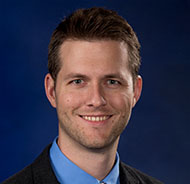
Eric Flynn
The International Workshop on Structural Health Monitoring will honor Eric Flynn (National Security Education Center, NSEC) with the Achenbach medal. The medal is awarded annually to a young researcher within 10 years of PhD receipt and who has made an outstanding research contribution in the field of Structural Health Monitoring. Flynn will receive the medal during a ceremony at Stanford University in September. The National Science Foundation, Boeing, Airbus, and Verizon sponsor the workshop, which is considered to be the premier structural health monitoring conference: http://structure.stanford.edu/workshop/awards_Achenbach.html
Flynn first came to the Lab for the Engineering Institute’s Dynamics Summer School in 2005, and returned the following summer as a LANL graduate research assistant. He conducted his PhD dissertation research in structural engineering at the University of California – San Diego and the Lab’s Engineering Institute. After earning a PhD, Flynn joined the Laboratory as a Director’s Funded postdoc in 2011. The Lab converted him to a R&D Engineer in 2013. His research focuses on nondestructive testing, signal processing, ultrasonics, applied statistics, optimization, and structural dynamics. He has received a Laboratory Early Career Research Grant (LDRD) for a novel hand-carried laser-ultrasound inspection system and a R&D 100 Award as the Principal Investigator for the Acoustic Wavenumber Spectrometer. Flynn has one patent awarded and another pending. He was a program developer for the Judicial Science School for New Mexico Judges; organizer, mentor, and instructor for the Los Alamos Dynamics Summer Schools; and a guest lecturer for a University of California – San Diego course on Structural Health Monitoring. Technical contact: Eric Flynn
Jeffrey Hyman honored with Fraunhofer Award
Jeffrey Hyman
The International Society for Porous Media (InterPore), on behalf of the Fraunhofer Institute for Industrial Mathematics (ITWM), honored Jeffrey De’Haven Hyman (Computational Earth Science, EES-16) with the 2015 Award for Young Researchers. This award is presented to young researchers within three years after completing a PhD and who make outstanding research contributions in the areas of porous and composite materials modeling and computer simulation. The award recognized him as a leader in the accurate modeling of pore scale flow and transport in diverse and complex pore structures, as well as revealing subtle links between porous media structure and flow and transport dynamics. The InterPore Newsletter stated: “He is quickly becoming a critical reference person in the quickly evolving field of digital rock physics.”
Hyman received the award during the 2015 InterPore conference in Padova, Italy. As the award winner, Hyman has been invited to spend approximately three months on joint research at the Fraunhofer ITWM. The award includes a monthly stipend and travel expenses.
Hyman received a PhD in applied mathematics with a minor in hydrology and water resources from the University of Arizona. In 2015, he was awarded postdoc funding by the Center for Nonlinear Studies (CNLS) to pursue his research at the Lab. Hyman splits his time between CNLS and EES-16. His postdoc mentors are Hari Viswanathan (EES-16), Jamal Mohd-Yusof (Applied Computer Science, CCS-7), and Gowri Srinivasan (Applied Mathematics and Plasma Physics, T-5). Hyman’s research in applied mathematics and subsurface hydrology has advanced the understanding of complex subsurface hydrological systems through creation of detailed physical simulations of flow in large, kilometer-scale, fracture networks and small, micrometer-scale, explicit pore microstructures using high performance computing. These simulations require the stochastic generation of realistic fracture networks and pore-structures based on geological data, one of Hyman’s specialties. He is a core developer of the computational software suite dfnWorks where his specialty is the generation of the fracture network and analysis of Lagrangian transport simulations. Technical contact: Jeffrey Hyman
Eda Aydogan and M. Arul Kumar receive TMS poster awards
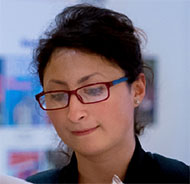
Eda Aydogan
Early career researchers Eda Aydogan and M. Arul Kumar (Materials Science and Radiation Dynamic, MST-8) won awards for their research presented in poster sessions at the TMS (The Minerals, Metals, & Materials Society) Annual Meeting and Exhibition in Orlando, Florida.
Eda Aydogan, a Graduate Research Assistant, received a best poster award in the Microstructural Processes in Irradiated Materials session for two of her posters. Her posters described materials research for applications in nuclear energy reactors. One poster presented new data on high-radiation tolerance of a ferritic alloy under ion irradiation. Aydogan’s study focused on the high dose irradiation swelling resistance of heat-treated and processed ferretic/martensitic steel variants. The work characterized irradiation-induced changes in microstructure and mechanical properties in comparison with other ion-irradiated alloys. The other poster described the development of tubing from radiation-tolerant, oxide-dispersion-strengthened ferritic alloys. The work developed innovative thermal spray deposition and hot extrusion processing methods to produce final tubes having a 0.5-mm wall thickness. The poster reported the effect of the processing methods on the oxide dispersion, irradiation response, and the mechanical properties of the materials.
Posters:
- “Microstructure and Mechanical Property Evolution during Tube Processing of Oxide Dispersion Strengthened (ODS) Ferritic Steels,” Eda Aydogan (Texas A&M University and MST-8), Osman Anderoglu, Stuart Maloy, and Sven Vogel (MST-8); and collaborators from Texas A&M, University of California – Santa Barbara, Oak Ridge National Laboratory, Case Western Reserve University, and Ames Laboratory.
- “Swelling Resistance Of Several Variants Of Ferritic Alloy EK-181 At High Doses During Self ion irradiation,” Aydogan, and collaborators from Texas A&M, Moscow Engineering and Physics Institute, Bochvar Institute of Inorganic Chemistry, Institute of Physics of Advanced Materials and Nanocenter, University of Florida, Massachusetts Institute of Technology, and Radiation Effects Consulting.
DOE’s Office of Nuclear Energy funded the work, which supports the Laboratory’s Energy Security mission area and Materials for the Future science pillar. She is pursuing a PhD in materials science from Texas A&M University. Osman Anderoglu and Stuart Maloy (MST-8) mentor her.

Arul Kumar
Arul Kumar, a Postdoctoral Research Associate, received a Young Professional Poster award for his poster in the TMS Structural Materials Division. He uses crystal plasticity-based materials modeling to explore the role of microstructure in the deformation behavior of hexagonal materials. He developed a model using a fast Fourier transform algorithm to study the stress heterogeneity associated with twinning in hexagonal close-packed materials, martensitic phase transformation in transformation-induced plasticity steels, and hydride precipitates in zirconium alloys. The model successfully predicts the local stress and strain fields induced by shear transformations, which greatly affect the plastic behavior of polycrystalline materials. The model predictions help researchers understand the deformation behavior of structural materials in used in applications for nuclear reactor technology, automotive technology, aviation, and defense.
Reference: “Modeling of Shear Transformation Induced Deformation Behavior in Crystalline Materials,” Arul Kumar and Carlos Tomé.
The DOE Office of Basic Energy Sciences program funded the research, which supports the Lab’s Global Security and Energy Security mission areas and the Materials for the Future science pillar.
TMS is an international professional society covering minerals, metals, and materials science and engineering, from minerals processing and primary metals production, to basic research and advanced applications. TMS offers young professionals the opportunity to network with experienced materials scientists and engineers and to gain recognition for their work and their accomplishments in the larger materials community. Technical contacts: Eda Aydogan and M. Arul Kumar
Chemistry
Direct current (DC) arc for the analysis of actinide materials

Figure 1. Schematic of DC arc spectroscopy.
Direct current (DC) arc spectroscopy dates back nearly a century to application of an arc distillation method for the analysis of metals. The method is often employed for the analysis of solid materials that are difficult to dissolve. Although DC arc spectroscopy is not as widely used now, it is considered the cornerstone for the commonly used inductively coupled plasma (ICP). The ICP was initially described as a “DC arc in a new jacket”, referring to the radio frequency (RF) coil wrapped around the ICP. With the advent of the ICP, DC arc spectroscopy became nearly extinct until Laboratory scientists resurrected the technique for very specific applications. This led to its first commercialization by Teledyne Leeman Labs.
DC arc spectroscopy uses a direct current potential that is applied between two vertical electrodes separated by an approximately 4 mm gap (Figure 1). An arc is sustained between the cathode and an anode when power is applied to the cathode. The anode has a hollowed out “cup” in which the sample (approximately 100 mg) is vaporized and excited. When ignited, the sample is ejected into the arc. The emission is collected through optical lenses and focused into a spectrometer. LANL widely employs this technique for actinide analysis including the heat-source pellets that fuel space explorations, such as the Mars Curiosity Rover. However, little is known about the actual plasma properties including excitation temperatures (Texe) and excitation-ionization properties for this method.
Therefore, LANL chemists conducted examined how the operating parameters (applied current and sheath gases) and sample matrices (concrete and actinides) affect the properties of the plasma.
The first parameter investigated was the applied current to the plasma. The current has a positive-linear effect on the Texe and then plateaus when plasma expansion occurs. Studies of excitation/ionization efficiency indicate that the ionic/atomic line ratio follows the same trend. More ionic species are formed due to the higher plasma temperatures because ionic states are more difficult to occupy at higher energy levels. The atomic lines provide better relative standard deviation, and the ionic lines increase the sensitivity achieved.
The second parameter was the introduction of a sheath gas (argon or molecular oxygen) in a chamber surrounding the plasma at different flow rates. In each of the environments, the Texe increases proportionally to the volume introduced. Oxygen has the greater effect. The increase in Texe occurs when the plasma does not need to ionize the “ambient” gas around it. Ionizing the primarily molecular nitrogen environment requires greater work in the plasma, thus lower temperatures. Monoatomic argon provides the best relative standard deviation because it requires little work to be ionized when sustaining the plasma. Higher plasma temperatures can be achieved.
The team examined matrix effects on the plasma. They compared the plasma characteristics of a “clean” plasma (containing only iron, zinc, and magnesium), an actinide-enriched plasma [containing plutonium (Pu) or uranium (U)], and concrete samples (containing Pu or U). The plasma temperature drops with increasing matrix-containing species. The concrete samples, containing a numerous trace elements along with Pu or U, yields a temperature of approximately 3500 K, while the “clean” sample yields a plasma temperature of approximately 5500 K.
These studies provide vital information regarding the ability of the plasma to ionize/excite species efficiently from solid samples. The team envisions that with these studies and further experiments, a more comprehensive analysis could be performed with improved sensitivity and precision. Ideally, plasma conditions could be estimated while working with various matrices (i.e. nuclear materials and concrete) to generate valuable analytical data.
Researchers include: Benjamin T. Manard, John Matonic, Robert Jump, Dennis Montoya, Alonso Castro, and Ning Xu (Actinide Analytical Chemistry, C-AAC). DOE/NE-75 and NNSA funded the work, which supports the Lab’s Nuclear Deterrence, Global Security, and Energy Security mission areas and the Science of Signatures and Materials for the Future science pillars through the analysis of actinide materials in a variety of matrices. Technical contact: Benjamin Manard
Earth and Environmental Sciences
Jumpstarting commercial-scale CO2 capture and storage
Carbon dioxide (CO2) capture, utilization, and storage (CCUS) is a climate mitigation technology that could dramatically reduce global emissions of this greenhouse gas while allowing the energy sector to continue generating electricity at coal-fired and natural gas power plants. CCUS involves capturing and compressing CO2 at large, stationary CO2 sources (e.g., power plants) and transporting the CO2 in dedicated pipelines to utilization or storage reservoirs (e.g., depleted oil fields and deep saline aquifers). CCUS may provide a vital technology to enable limiting a global temperature increase to 2 °C. Implementing CCUS might enable a gradual transition to energy sources that emit less CO2 per unit of energy while continuing to leverage the useful lifetime of the existing energy infrastructure. However, the technology has yet to be widely deployed at a commercial scale despite multiple high-profile demonstration projects.
In a perspective paper published in Greenhouse Gases: Science and Technology, Laboratory researchers suggested a new approach that could potentially overcome many barriers to deployment and jumpstart commercial-scale CCUS. To date, substantial effort has focused on technology development to reduce the costs of CO2 capture from coal-fired power plants. Instead, the Lab team proposed that near-term investment could focus on implementing CO2 capture on facilities that produce high-value chemicals/products such as such as ethanol, iron/steel production, and oil refining (Figure 2). High-value chemicals/product industries collectively emit roughly the same amount of CO2 as natural gas power plants.
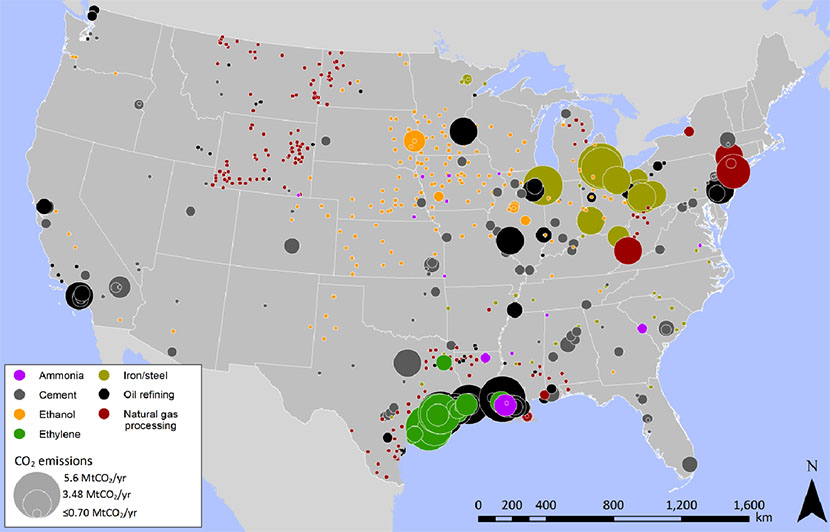
Figure 2. Map of the contiguous US shows the location of facilities that produce high-value chemicals/products and the amount of CO2 emitted.
The researchers compared the estimated increase in the cost of the production price of product due to the addition of CO2 capture for fossil fuel-fired power plants and for high-value chemicals/products (Figure 3). The scientists suggest that the high-value chemicals/products facilities could better absorb the expected impact of the marginal increase than could coal-fired power plants. In addition, the captured CO2 could be sold for enhanced oil recovery (EOR). Enhanced oil recovery using anthropogenic (or byproduct) CO2 has a similar carbon footprint to hybrid electric vehicles and plug-in hybrid electric vehicles using a typical balance of electricity sources in the United States. The researchers introduce a specific example to demonstrate the new approach: ethylene production in the U.S. Gulf region coupled with nearby enhanced oil recovery production. Deploying this large-scale system is potentially possible in this region, where numerous large and clustered sources of CO2 as a byproduct of ethylene production as well as enhanced oil recovery opportunities are present. Such a visible integrated system could increase public awareness and demonstrate an approach that reduces CO2 emissions while complementing existing CCUS technology development strategies.
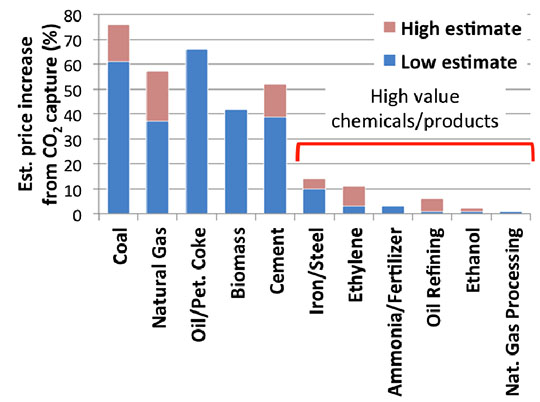
Figure 3. Comparison of captured CO2 with estimated price increase from the capture.
Reference: “Jumpstarting Commercial-scale CO2 Capture and Storage with Ethylene Production and Enhanced Oil Recovery in the U.S. Gulf,” Greenhouse Gases: Science and Technology 5, (3) 1 (2015); doi: 10.1002/ghg. Authors include: Richard Middleton, Philip Stauffer, and Hari Viswanathan (Computational Earth Science, EES-16); J. William Carey (Earth System Observations, EES-14); Jonathan Levine (DOE National Energy Technology Laboratory); and Jeffrey Bielicki (The Ohio State University).
The US-China Clean Energy Research Center, Advanced Coal Technologies Consortium (ACTC), the DOE Big Sky Carbon Sequestration Partnership CO2-EOR, and the Los Alamos Laboratory Directed Research and Development (LDRD) program funded different aspects of the work. The research supports the Lab’s Energy Security mission area and the Materials for the Future science pillar via the evaluation of technologies to capture and sequester anthropogenic CO2 emissions. Technical contact: Richard Middleton
Educational Outreach
Sequencing and bioinformatics Training at Los Alamos
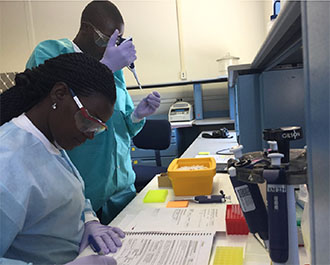
Photo. Scientists from Kenya participate in the training.
The Genomics Team in Bioscience (B) Division organized hands-on training on next generation genome sequencing and bioinformatics. The training, which took place at the Lab’s Health Research Laboratory, involved 31 scientists representing 12 countries. This was the third year that LANL has hosted this training event, and it is the first year that it was held completely on-site, to include hands-on work for all participants. Organizers divided the training into three parallel tracks: wet-lab, introductory bioinformatics, and advanced bioinformatics. The Genomics Team in the Bioenergy and Biome Science Group (B-11) worked together with Bioscience Division leadership and support staff to teach and coordinate the workshop.
For more than three years, Los Alamos scientists have developed and enhanced sequencing and bioinformatics capabilities worldwide under programs within the U.S. Department of State and the Defense Threat Reduction Agency (DTRA-Department of Defense). The purpose is: 1) to establish or improve technological capabilities of laboratories around the world to combat infectious diseases through improved characterization, and faster, more accurate detection; and 2) promote a sustainable culture of safe and secure laboratory practice through the education and training of staff.
For instance, in 2012, the Laboratory began a relationship with the Jordan University of Science and Technology to establish a next generation sequencing laboratory, train the scientists on genomics principles and technologies, and form new BioRisk Management and Genomics Training Divisions. Lab scientists also traveled to the Republic of Georgia in 2013 (and hosted Georgian scientists at LANL) to set up equipment and train personnel in sequencing and bioinformatics for their new Center for Public Health Research. These programs have continued to expand each year. In 2015, team members have traveled to the Uganda Virus Research Institute in Uganda and the Centre International de Recherches Medicales in Gabon to begin similar collaborations. The team is also developing relationships with scientists in Kenya and South Africa.
Participants in this year’s workshop included scientists from additional countries wishing to develop genomics expertise, including Cambodia, Egypt, Ethiopia, Liberia, Peru, and even the U.S. Many attendees came from centers that already conduct some sequencing and analysis but are looking for advanced training, and others came for a more general introduction. The knowledge gained during the training will help these countries with rapid analysis of clinical samples to enable early detection, monitoring, and containment of disease outbreaks. For example, the standing collaboration between LANL and Uganda has involved the analysis of clinical samples of suspected hemorrhagic fevers. Future work includes investigation of arboviruses endemic to Uganda.
DoD-DTRA and the U.S. Department of State funded the conference, which supports the Lab’s Global Security and Energy Security mission areas and the Science of Signatures science pillar through the analysis and identification of pathogens and other organisms. Technical contacts: Tracy Erkkila, Patrick Chain, and Helen Cui
LANSCE School on Neutron Scattering opens the mesoscale world to students
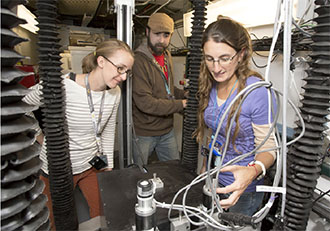
Photo. Students in the LANSCE School on Neutron Scattering learn about the surface profile analysis reflectometer (SPEAR) capabilities with staff scientist Erik Watkins (Materials Synthesis and Integrated Devices, MPA-11).
The 11th Los Alamos Neutron Science Center (LANSCE) School on Neutron Scattering spent nine days teaching how neutron scattering can benefit studies of materials at the mesoscale (nm to mm range, between the atomic and macroscopic scales). The school examined the influence of surfaces, interfaces, and microstructure on the properties of materials and functionalities. Thirty-six selected applicants from 28 universities in five countries and staff from the Lab participated in lectures, tutorials, tours, and hands-on experiments at LANSCE and the Center for Integrated Nanotechnologies (CINT). The majority of the participants did not have prior exposure to neutron scattering techniques.
The purpose of the LANSCE school is to develop a strong, diverse neutron scattering community by introducing early-career scientists to a variety of neutron scattering techniques and demonstrating how they complement other materials analysis techniques in a selected topical area. This year’s topic, mesoscale science, has the potential to revolutionize the discovery, design, and application of materials by revealing properties that can be tailored to create new functionality. Students became familiar with several neutron and x-ray scattering approaches (powder diffraction, small angle neutron scattering, local structure determination, and neutron reflectometry) and their use in addressing important materials science questions at the mesoscale realm. The mesoscale is often difficult to probe using other techniques.
Anna Llobet (LANSCE Weapons Physics, P-27) and Heinz Nakotte (NMSU) co-directed the school. Edwin Fohtung (NMSU), Graham King (Materials Science in Radiation and Dynamics Extremes, MST-8), and Jarek Majewski (MPA-CINT) served as organizing committee co-chairs. Experts from LANL (Materials Science and Technology, Materials Physics and Applications, Theoretical, and Chemistry divisions), Oak Ridge National Laboratory (Spallation Neutron Source), University of California – Berkeley and Santa Barbara, Columbia University, Princeton University, Queen’s University, New Mexico State University (NMSU), and Colorado School of Mines presented lectures. Overview presentations addressed the importance of mesoscale science. John Sarrao (Associate Director of Theory, Simulations & Computation, ADTSC) discussed opportunities to design architectures and interactions among nanoscale units to create new macroscopic behavior and functionality. Chris Barnes (Capture Manager for Matter-Radiation Interactions in Extremes, MaRIE) described the challenge of dynamic mesoscale imaging and new scientific opportunities that would be available with MaRIE, the Lab’s proposed experimental facility for the time-dependent control of dynamic material performance.
The school introduced participants to the capabilities of a NNSA-funded national user facility. The facility has become a bridge for many who return as LANSCE users, helping to foster the next
generation of LANSCE staff scientists, building new collaborations with university researchers, and strengthening the community of neutron science in all its diversity.
The National Science Foundation sponsored the students. LANL, the Lab’s Institute for Materials Science, and the MaRIE project funded instructor and local expenses. LANSCE and NMSU provided planning and logistics; and CINT supplied special experiment support. Technical contact: Anna Llobet
High Performance Computing
Laboratory demonstrates extreme scale indexing for large-scale data analysis
As high performance computers and data requirements increase in size, handling large volumes of data becomes a bottleneck due to the resources required to move, search, and analyze all of the data at once. A solution to this complicated problem lies in identifying, retrieving, and analyzing smaller subsets of data. This method uses a key/value store, a database where entries are referenced by a single key. A collaboration of Los Alamos with EMC has developed MDHIM (Multidimensional Hashed Indexed Middleware), a software framework that enables applications to take advantage of the mechanisms provided by a parallel key/value store (storing data in global, multidimensional order and subsetting massive data in multiple dimensions).
As an analogy, imagine moving all the contents of several houses while keeping order of the contents. This would require numerous storage bins. Retrieving the desired contents would necessitate the development of a way to keep track of where the items are located. This same principle applies to the new MDHIM software.
Distributed key/value stores are a solution for big data in the cloud environment, but perform poorly in the high performance computing environment. Therefore, the team developed MDHIM as a parallel key/value store framework for high performance computing and big data analysis, which are required in many of the Laboratory’s scientific programs.
MDHIM takes the concept of the key/value store and adds the ability for multiple servers to serve portions of the data (key space). The distributed, parallel key/value store framework allows parallel applications to use the key/value store in parallel. Thus, each instance of the program can insert and retrieve records using different MDHIM servers at the same time. This load balances accesses to the data, which improves performance when many clients are able to access different servers simultaneously. MDHIM can perform more than a billion key/value inserts per second into a globally ordered key space, and represent petabytes of data with mega- to gigabytes of representation data. In addition, MDHIM takes advantage of network speeds provided by the high-speed network interconnects found in supercomputers and can be easily integrated into a scientific application. High-speed networks, such as Infiniband, can reach speeds of more than 200 gigabits per second using specialized communication modes, whereas Ethernet can only reach speeds of 10 gigabits per second. MDHIM supports these native communication modes through MPI (message-passing interface, a standardized message-passing system). This allows MDHIM to transfer data at speeds as high as 200 gigabits per second. MDHIM is highly scalable, can easily be added to a scientific application, and does not require long-running server processes.
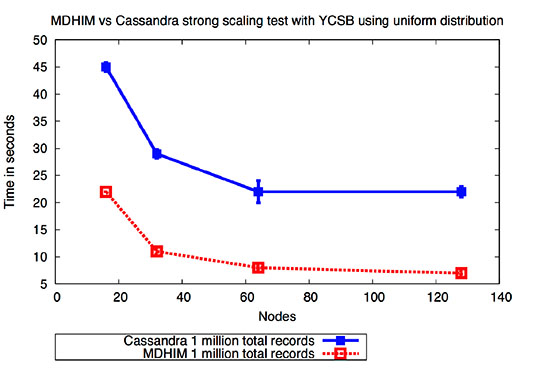
Figure 4. Plot of the strong scaling performance comparison of MDHIM and Cassandra, both of which are running the Yahoo! Cloud Serving Benchmark (YCSB: https://github.com/brianfrankcooper/YCSB) using a uniform distribution. For each run, 1 million records were inserted/retrieved. The results show that MDHIM outperforms Cassandra in each test.
The researchers conducted scaling performance comparison tests on the Laboratory’s Mustang high performance computing cluster. The team compared MDHIM and Cassandra, a popular key/value store system, with YCSB (Yahoo! Cloud Serving Benchmark). Using this standard big data benchmark, the scientists found that the MDHIM performance more than triples that of Cassandra on high performance computing systems. The researchers attributed the superior performance of MDHIM to the use of native high-speed interconnects and a more uniform data distribution, enabling a more balanced server load.
MDHIM makes it possible to move, search, and analyze massive amounts of data run on supercomputers, enabling analysis and visualization of such big-data resources on unprecedented scales. It has been used in collaboration with the Department of Defense, which is applying the tool extensively within the Storage and I/O portions of the DOE’s FastForward Project. This public-private partnership between industry, the DOE Office of Science, and the NNSA supports the development of technology that reduces economic and manufacturing barriers to construct exaflop-sustained systems.
Reference: “Key/Value Framework for HPC” will be presented at HotStorage 2015, a workshop of the Advanced Computing Solutions Association. The MDHIM development team includes: Hugh Greenberg (System Integration, HPC-5), Gary Grider (High Performance Computing, HPC-DO), and John Bent (EMC).
The DOE Office of Science funded this work, which supports the high performance computing and data analysis needs of the Lab’s mission areas and the Information, Science, and Technology science pillar. Technical contact: Hugh Greenberg
LANSCE
Lujan Center proposal call for upcoming run cycle
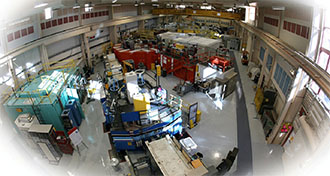
Photo. Lujan Center experimental area.
The Los Alamos Neutron Science Center (LANSCE) is issuing a Call for Proposals for experiments to be run at the Lujan Center's moderated neutron source during Fiscal Year 2016 (October 1, 2015, – September 30, 2016). The deadline for submitting proposals is July 17, 2015, 5 PM (MDT).
Three nuclear science flightpaths [5, 12, and DANCE (Detector for Advanced Neutron Capture Experiments)] and three materials science flightpaths [SMARTS (Spectrometer for Materials Research at Temperature and Stress), HIPPO (High-Pressure-Preferred Orientation), and ASTERIX (Neutron reflectometer/diffractometer)] comprise the suite of instruments for this call. More information regarding the proposal call: http://lansce.lanl.gov/uresources/Lujanproposals.shtml
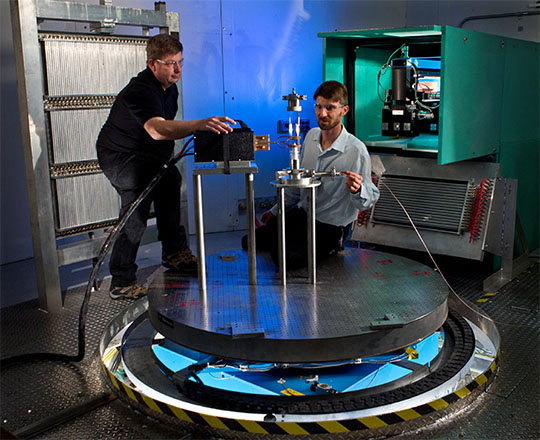
Photo. SMARTS is a third-generation neutron diffractometer optimized to study of engineering materials. The photo shows Dylan Byler and Matt Reiche (Materials Science in Radiation and Dynamics Extremes, MST-8) using SMARTS.
The Lujan Center utilizes 800 MeV protons, provided by the LANSCE accelerator facility at LANL, to produce intense pulses of moderated thermal or cold neutrons mainly in support of stockpile stewardship programs and other national security missions that benefit from the unique capabilities of this neutron source. Currently, NNSA programmatic sponsors fully support Lujan Center operations. However, approximately 10% of the beam time at Lujan Center is available for compelling scientific proposals from institutions without programmatic sponsors and for proprietary work or work-for-others agreements. Overview of the Lujan Center: lansce.lanl.gov/lujan
For technical questions regarding details involved in fielding experiments, contact Fredrik Tovesson (tovesson@lanl.gov, 505-665-9652) for nuclear science or Don Brown (dbrown@lanl.gov, 505-667-7904) for material science. To submit classified versions of proposals, contact Tovesson for specific directions on submission. Direct other questions to the Lujan Center User Office (lujan-uo@lanl.gov, 505-667-6069). Technical contacts: Frederick Tovesson and Don Brown
Materials Physics and Applications
Interface engineering enables a path forward for magnetoelectric multiferroics
Los Alamos scientists and collaborators have discovered a way to realize magnetoelectric coupling and net magnetic moment in antiferromagnetic BiFeO3 (BFO). This finding has potential utility for designing high-density data storage platforms of the future. The journal Scientific Reports reported the research.
BFO has outstanding ferroelectric properties. However, there is virtually no net moment to interact with an applied magnetic field. This lack of a magnetic handle impedes its development for potential applications. Therefore, the researchers developed a composite of two materials [La0.7Sr0.3MnO3 (LSMO) and BFO], neither of which independently exhibits a dielectric response to a magnetic field. Polarized neutron reflectometry measurements of the composite reveal significant net uncompensated magnetization in BFO. The authors conclude that the large uncompensated magnetization of BFO in the superlattice is a consequence of unique features associated with the superlattice, e.g., its growth, strain, architecture, proximity to a ferromagnet, etc. Below 179 K, LSMO is ferromagnetic and BFO exhibits net uncompensated magnetization; the magnetization of BFO is opposite to that of the LSMO. The magnetic order parameters have the same dependence with temperature, suggesting that LMSO induces the uncompensated magnetization of BFO. The magnetization enables a magnetic field to change the dielectric properties of the superlattice. The team cited this phenomenon as an example of synthetic magnetoelectric coupling.
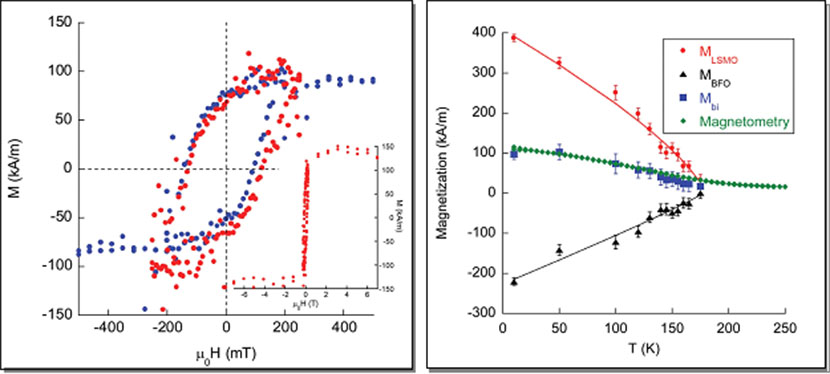
Figure 5. (Left panel): Magnetization vs. magnetic field for superlattice measured from (blue) ±0.5 T and (red, and inset) ±7 T at 10 K. (Right panel): The temperature dependence of the magnetizations for LSMO (circles) and BFO (triangles) layers in the superlattice, (squares) the thickness-weighted average of these magnetization and (diamonds) the moment of the sample measured with magnetometry normalized by the volume of the superlattice film.
The finding represents a new path to produce synthetic magnetoelectric coupling in a nanocomposite at 10 K. This approach means that rather than requiring discovery of a single-phase multiferroic for useful applications, the challenge becomes more manageable – one of using interface engineering to
couple dissimilar materials intimately. The team concludes that the controlled creation of magnetic moment in BFO is an important step toward the design and implementation of integrated oxide devices for next generation magnetoelectric data storage platforms.
Reference: “Synthetic Magnetoelectric Coupling in a Nanocomposite Multiferroic,” Scientific Reports 5, 9089 (2015); doi: 10.1038/srep09089. Authors: Prashant Jain (Materials Synthesis and Integrated Devices, MPA-11); Qiang Wang, Z. Bi, and Quanxi Jia (MPA-CINT); Towfiq Ahmed and Jianxin Zhu (Physics of Condensed Matter and Complex Systems, T-4); Michael Fitzsimmons (formerly of Lujan Center, LANSCE-LC); M. Moldan (Universidad Complutense de Madrid, Spain); A. Glavic (Oak Ridge National Laboratory); C. Urban (University of California – San Diego), and M. Varela (Universidad Complutense de Madrid and Oak Ridge National Laboratory).
The Laboratory Directed Research and Development (LDRD) program funded the work, which was performed, in part, at the Center for Integrated Nanotechnologies (CINT), an Office of Science User Facility operated for the DOE Office of Science. This work has benefited from the use of the Spallation Neutron Source (Oak Ridge National Laboratory) and the LANSCE Lujan Center (Los Alamos National Laboratory), which were at the time funded by the Scientific User Facilities Division of the DOE’s Office of Basic Energy Sciences; and the National High Magnetic Field Laboratory (at Los Alamos), which the National Science Foundation sponsors. The work supports the Laboratory’s Energy Security mission area and the Materials for the Future science pillar through the use of materials with tailored functionality to enable technological innovations in information storage, sensing, and computing. Technical contact: Quanxi Jia
Materials Science and Technology
Using neutrons to predict the lifetime of bridges
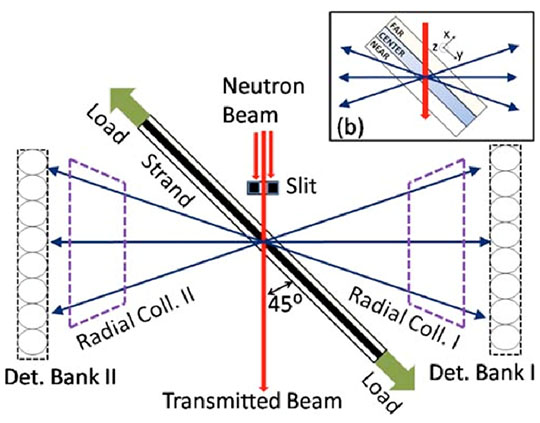
Figure 6. Schematic of the SMARTS diffractometer. The intersection of the incident beam and the acceptance fans of the radial collimators define the probe volume (inset). The entire load frame is mounted on a precision translator and can be moved to bring the center of each wire into coincidence with the probe volume. Detector bank II measured the longitudinal strains in this schematic.
Civil Engineering, the magazine of the American Society of Civil Engineers, highlighted the advantages of using neutron diffraction to evaluate large-scale engineering structures, such as the behavior of suspension bridge cables under extreme conditions. Columbia University researchers and Los Alamos collaborators analyzed bundled cables from the heavily trafficked George Washington Bridge that crosses the Hudson River to connect New York City and New Jersey.
The research constitutes the first use of neutron diffraction on engineering-level samples from an existing civil structure. It was performed in part using the spectrometer for materials research at temperature and stress (SMARTS) at Los Alamos Neutron Science Center’s Lujan Center. Neutron diffraction has an advantage of providing a nondestructive and nonintrusive means to gather crucial data from strands buried deep inside the cable. Other measurement approaches, such as inserting strain gauges, cause additional friction between wire strands, which ultimately alter the boundary conditions.
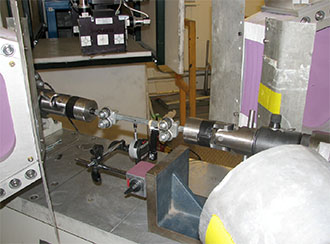
Photo. Sample mounted in the load tester of the SMARTS diffractometer.
The measurements revealed that prior assumptions about load sharing between individual strands in the cable bundle were conservative and have led to underestimations of bridge lifetime. The researchers theorize that friction and cable curvature and compaction might play a role in how the broken wires regain their load-carrying capacity. The neutron diffraction study produced validation data that aids the development of predictive models for aging infrastructure. These results are important to the federal and state transportation departments that address pervasive structural deficiencies in the nation’s bridges.
Reference: “Subatomic Particles Aid Investigation of Large Bridge Components,” by Laurie Shuster, Civil Engineering, April 21, 2015. Los Alamos researchers include: Bjørn Clausen and Donald Brown (Materials Dynamics in Radiation and Dynamics Extremes, MST-8) and Thomas Sisneros (Subatomic Physics, P-25). Civil Engineering, founded in 1930, is circulated to more than 140,000 civil engineers around the world.
The National Science Foundation funded the research at Columbia University. The work benefited from the use of the Lujan Center, which the DOE Office of Basic Energy Sciences sponsored. The research supports the Laboratory’s Global Security mission area and the Materials for the Future science pillar by demonstrating experimental measurements that are vital for the validation of structural and materials models. Technical contact: Bjørn Clausen
Physics
Recent LANSCE run cycle was one of the most prolific for NNSA research
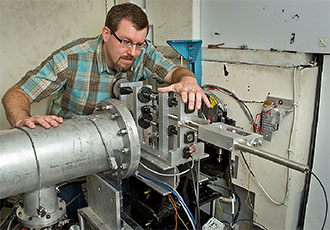
Photo. Postdoc Dan Olds (Materials Dynamics in Radiation and Dynamics Extremes, MST-8) sets up a LQD experiment.
The broad neutron energy spectrum available at the Los Alamos Neutron Science Center (LANSCE) enabled eight different studies performed during the last run cycle from October 2014 to February 2015. The results revealed materials and nuclear properties of plutonium (Pu) – from surface studies on 50-mg plutonium thin films to prompt neutron spectra for fission of the isotope 239Pu.
Neutron production targets at LANSCE’s Weapons Neutron Research Facility (WNR) and Lujan Center provide complementary neutron energies spanning 1 meV-600 MeV, enabling advances in fundamental and applied materials research and stockpile stewardship science. The science-based Stockpile Stewardship Program combines advanced scientific and experimental capabilities with high-performance supercomputing to help scientists and engineers understand and resolve issues in the nation’s nuclear deterrent.
A broad range of program development activities aligned the Lujan Center materials’ user program with the NNSA mission, making the most run cycle one of the most prolific for plutonium research, with great impact to NNSA programs. For example, researchers used the surface neutron reflectometer Asterix to perform the first neutron reflectometry characterization of less than 50-mg plutonium oxide (PuO2) thin films. Such preliminary work is critical to characterizing interfaces and understanding the effect of the existence or development of nonhomogeneous phases at different surface depths of real parts. These phases might affect processes and degradation such as hydride formation or oxidation. Scientists employed the small angle neutron scattering instrument LQD (low-Q diffractometer) and Asterix to perform feasibility studies of highly neutron absorbing materials (dysprosium and erbium). LQD allows scientists to characterize mesoscale defects created by aging or damage in these materials. The first experiments on plutonium samples at LQD and Asterix proved that it is feasible to characterize the effects of aging and annealing in the mesoscale in the upcoming run cycle.
Diffraction and inelastic neutron scattering measured the local structure and phonon density of states of plutonium/gallium (PuGa) alloys using highly neutron absorbing 239Pu as a function of temperature on the neutron powder diffractometer (NPDF) and filter difference spectrometer (FDS). Scientists characterized the microscopic origin of the stabilization mechanisms and the local effects of radiation damage or stress. They also examined the mechanism behind the phase transitions that remain elusive from average structure studies and which are impossible to obtain using x-rays. The team used the filter difference spectrometer to investigate the phonon density of states (pDOS) on PuGa compounds, extending the data range over which the pDOS has been observed in such compounds. This information informs first-principle calculations leading to the vibrational models and theoretically obtained equations of state needed to simulate dynamic experiments. Overall, the work demonstrated the feasibility of using available 239Pu, which is highly neutron absorbing, rather than the lower absorbing and rare isotope 242Pu, to perform neutron scattering experiments. These combined sophisticated modeling efforts and data reduction methods enable the Lujan Center to respond to future NNSA needs effectively and efficiently.
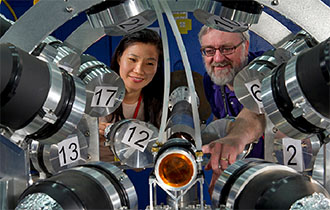
Photo. Hye Young Lee and John O'Donnell (LANSCE Weapons Physics, P-27) check the Chi-Nu instrument at the Weapons Neutron Research Facility.
The high-energy neutrons at Weapons Neutron Research Facility (WNR) enabled the team to achieve nuclear science milestones. The Chi-Nu detector array, developed by LANL and Lawrence Livermore National Laboratory to measure the prompt fission neutron spectra of 239Pu, greatly benefitted from the development of a new integrated data acquisition system. The LANSCE risk mitigation project enabled an increase of a factor of 2.5 in the beam rate. The scientists achieved important NNSA milestones on the prompt fission neutron spectra of the uranium isotope 235U and preliminary 239Pu results.
The fission Time Projection Chamber is a NNSA instrument developed in collaboration with Lawrence Livermore National Laboratory to achieve 1% accuracy in determining 239Pu cross sections. The chamber delivered measurements leading towards the achievement of a Level 2 milestone. Successful preliminary results provided 239Pu/235U cross-section ratios.
Researchers fielded the SPectrometer for Ion DEtermination in fission Research (SPIDER) and the total kinetic energy (TKE) release in fission in both the Lujan Center and WNR. They obtained data enabled by the facilities’ complementary neutron sources and broad energy range. During the recent run cycle, experiments determined the total kinetic energy dependence on incident neutron energy for fission of 239Pu and the fission product yields of 239Pu using the 2E-2v method.
Researchers from Physics (P), Materials Science and Technology (MST), and Materials Physics and Applications (MPA) divisions conducted the experiments, and Accelerator Operations and Technology (AOT) Division enabled operation of LANSCE. NNSA funded the 2015 run cycle, which supports the Lab’s Nuclear Deterrence mission area and Nuclear and Particle Futures and Materials for the Futures science pillars through work sustaining Stockpile Stewardship needs for actinide material and nuclear property data. Technical contact: Anna Llobet
Science on the Roadmap to MaRIE
Additively manufactured U6Nb heat-treated in situ in SMARTS
A Lawrence Livermore National Laboratory (LLNL) and LANL team heat-treated uranium-niobium (6 wt.%) alloy (U6Nb) in situ in the Spectrometer for Materials Research at Temperature and Stress (SMARTS), at the Los Alamos Neutron Science Center (LANSCE). Their work aimed to understand the materials processing methods that LLNL performs. The results provided valuable data for improving LLNL’s additive manufacturing techniques.
Additive manufacturing (AM) represents a relatively new fabrication paradigm in which parts are built from the ground up to final geometry, as opposed to traditional manufacture, where large blanks are produced and machined to final dimensions. The resulting parts produced via additive manufacturing should be thoroughly characterized because the process is very different from traditional manufacture.
Traditionally processed U6Nb usually has a monoclinic (a’’) crystal structure. Previous experiments at SMARTS showed that as-processed, the U6Nb material additively manufactured at LLNL has a two-phase structure comprised of roughly equal amounts of the monoclinic and tetragonal (g0) crystal structure. Following the LLNL heat treatment (10 hours at 1000°C), the material is single phase g0.
The team heated an as-processed sample in-situ on SMARTS with a heating rate of 100°C/min followed by a 1000°C (in the cubic (g) phase) hold for 10 hours. The timing of the heat treatment matches well with the data integration time (approximately 5 minutes) on SMARTS. Figure 7 shows several diffraction patterns, before and after heat-treating, when first reaching 1000°C, and after 10 hours at 1000°C. The diffraction data when the sample first reached 1000°C is indistinguishable from that 10 hours later. The final diffraction pattern after the heat treatment is consistent with the sample heat treated ex situ at LLNL. The researchers concluded that the aspects of the microstructure that can be monitored with diffraction – Nb concentration, internal stress, dislocation density, and texture – did not change during the hold at 1000°C. Therefore, the researchers conclude that the change must have occurred during the heating phase.
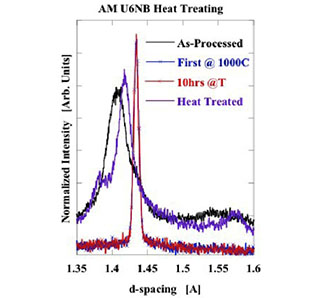
Figure 7. Diffraction patterns, before and after heat treating, when first reaching 1000°C and after 10 hours at 1000°C, demonstrate that the parts of the microstructure that can be monitored with diffraction must have changed during the heating phase.
LLNL can use these results to better design the heat treatment process to achieve the final microstructural goal. Moreover, the work represents the philosophy driving MaRIE, the Laboratory’s proposed experimental facility for control of time-dependent material performance. The philosophy is to understand the manufacturing process to enable optimization, control, certification, and qualification. The limited data rate at SMARTS allows researchers to monitor the microstructure during the relatively long heat treatment. In contrast, the very high data rate associated with MaRIE would allow monitoring of the material deposition process itself, which happens in a fraction of a second.
The NNSA Primary Assessment Technologies Campaign funded the work, which supports the Laboratory’s Nuclear Deterrence mission area and Materials for the Future and Science of Signatures science pillars. Researchers include: Amanda Wu (LLNL), Don Brown and Bjorn Clausen (Materials Science in Radiation and Dynamics Extremes, MST-8). Technical contact: Don Brown
Theoretical
Collective transport properties of driven skyrmions with random disorder
In an article published in Physical Review Letters, Laboratory researchers used large-scale simulations to model the transport behavior of skyrmionic spin textures in chiral magnets.
Skyrmions are particle-like objects that are stabilized by their topological properties. They were first proposed in 1962 by former Los Alamos physicist Tony Skyrme in the context of high-energy physics, as a possible way to obtain particle-like solutions in field theories for baryons. However, skyrmions were later found to also manifest themselves in condensed matter systems. In 2009, skyrmionic spin textures were experimentally discovered in chiral magnets such as MnSi, where they form triangular lattices; recently, they have even been observed to exist at room temperatures. With their particle-like nature, magnetic skyrmions exhibit great promise as a medium for data storage and transfer due to their small size (approximately 50-100 nm) and low depinning current compared with other micromagnetic structures such as bubbles. However, to achieve commercial applications of this technology, precise control of skyrmion motion will be required. Therefore, a greater understanding of skyrmion pinning and transport is needed.
The paper presents a major discovery: moving skyrmions interacting with randomly distributed pinning sites exhibit a rich variety of distinct non-equilibrium phases. This phenomenon arises due to the pronounced role in skyrmion systems of the Magnus force. Magnus forces act in a perpendicular direction to the velocity of the moving object. One of the best-known examples of such forces occurs for a fast rotating baseball or soccer ball, where the Magnus effect causes the ball’s trajectory to curve as it travels through the air. The motion of skyrmions differs greatly from that of most other driven particle systems because the Magnus force can be very strong. The Magnus contribution to the motion of skyrmions can be ten times stronger than other forces on the skyrmions, in stark contrast to the usual case where the Magnus force slightly perturbs the particle motion. Skyrmions belong to a new class of dynamical systems, termed “Magnus-dominated.”
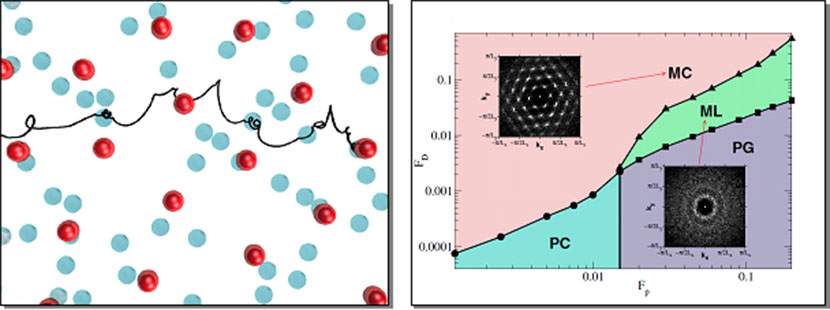
Figure 8. (Left panel): Real-space image of skyrmions (dark red dots) being driven through randomly arranged pinning sites (blue dots) during a plastic flow phase. The trajectory of a single skyrmion is shown (in black), exhibiting spiraling motion inside the pinning sites, and curved motion with cusps outside the pinning sites due to many-body effects. (Right panel): Skyrmion dynamical phase diagram as a function of drive and pinning strength, highlighting the various phases (PC: pinned crystal; PG: pinned amorphous glass; ML: moving liquid; MC: moving crystal). Insets show structure factors for the disordered and ordered moving phases."
The team found that when Skyrmions are driven over a random landscape of disorder such as arises naturally when materials are fabricated, the direction of motion of the skyrmions gradually rotates as the magnitude of the drive is increased. The drive direction remained unchanged. The Magnus effect at low drives induces swirling motions in the skyrmion trajectories. Figure 8 (left panel) shows the simulated locations of skyrmions (red dots) moving over trapping sites (blue dots). The trajectory of a single skyrmion is highlighted to show the swirling motion of the skyrmions as they move through the sample. The scientists demonstrated the existence of a variety of new skyrmion phases including a skyrmion glass, liquid, and moving crystal. The researchers mapped a dynamical phase diagram as a function of the strength of the disorder and the driving, revealing the non-equilibrium phase transitions between these phases. Figure 8 (right figure panel) depicts this diagram and indicates where the different phases occur and the structure factors S(k) for the moving disordered and moving crystal states. The transitions between skyrmion phases are similar to equilibrium transitions between solid and liquid states that occur at various temperatures and pressures. However, in the non-equilibrium skyrmion system, the location of transitions between phases is characterized by a dynamic parameter, the strength of the drive.
Besides providing a new system to explore the role of Magnus effects in strongly interacting systems, the work addresses the important question of understanding how skyrmions move in order to realize possible future applications as a medium for high-density, low-power information storage.
Reference: “Collective Transport Properties of Driven Skyrmions with Random Disorder,” Physical Review Letters 114, 217202 (2015); doi: 10.1103/PhysRevLett.114.217202. Authors: Charles Reichhardt (Physics of Complex Matter and Condensed Systems, T-4 and Center for Nonlinear Studies, CNLS affiliate); Dipanjan Ray and Cynthia Olson Reichhardt (Physics and Chemistry of Materials, T-1 and CNLS affiliate).
Laboratory Directed Research and Development (LDRD) funded the work through the Center for Nonlinear Studies (CNLS). The research supports the Lab’s Energy Security Mission area and the Materials for the Future science pillar by providing insight into the development of materials for information storage. Technical contacts: Charles Reichhardt and Dipanjan Ray








